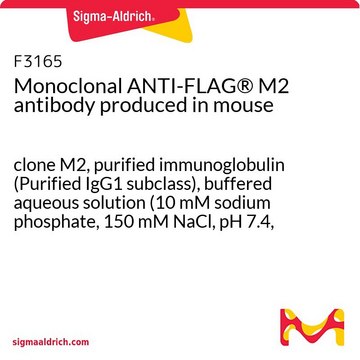E9158
p3xFLAG-Myc-CMV™-23 Expression Vector
Shuttle vector for transient expression of secreted dual tagged N-terminal 3xFLAG and C-terminal c-myc fusion proteins
Sign Into View Organizational & Contract Pricing
All Photos(3)
About This Item
UNSPSC Code:
12352200
Recommended Products
tag
3X FLAG tagged
c-Myc tagged (C-terminal)
grade
for molecular biology
form
buffered aqueous solution
shipped in
dry ice
storage temp.
−20°C
General description
The p3XFLAG-Myc-CMV™-23 Expression Vector is a 4.8 kb derivative of pCMV5 used to establish transient expression of secreted, dual-tagged N-terminal 3XFLAG™ and C-terminal c-myc fusion proteins in mammalian cells. The vector encodes three adjacent FLAG epitopes (Asp-Tyr-Lys-Xaa-Xaa-Asp) and a c-myc epitope (EQKLISEEDL) upstream and downstream of the multiple cloning sites, respectively. The third FLAG epitope includes the enterokinase recognition sequence, allowing cleavage of the 3XFLAG peptide from the purified fusion protein. The incorporation of 3XFLAG in the expression vector results in increased detection sensitivity using ANTI-FLAG M2 antibody.
p3XFLAG-Myc-CMV-23 Expression Vector is a shuttle vector for E. coli and mammalian cells. Efficiency of replication is optimal when using an SV40 T antigen expressing host.
The p3XFLAG-CMV-7-BAP Control Plasmid is a 6.2 kb derivative of pCMV5 used for transient intracellular expression of N-terminal 3XFLAG bacterial alkaline phosphatase fusion protein in mammalian cells. The vector encodes three adjacent FLAG epitopes (Asp-Tyr-Lys-Xaa-Xaa-Asp) upstream of the multiple cloning region. This results in increased detection sensitivity using ANTI-FLAG M2 antibody.The third FLAG epitope includes the enterokinase recognition sequence, allowing cleavage of the 3XFLAG peptide from the purified fusion protein.
Vector Maps and Sequences
p3XFLAG-Myc-CMV-23 Expression Vector is a shuttle vector for E. coli and mammalian cells. Efficiency of replication is optimal when using an SV40 T antigen expressing host.
The p3XFLAG-CMV-7-BAP Control Plasmid is a 6.2 kb derivative of pCMV5 used for transient intracellular expression of N-terminal 3XFLAG bacterial alkaline phosphatase fusion protein in mammalian cells. The vector encodes three adjacent FLAG epitopes (Asp-Tyr-Lys-Xaa-Xaa-Asp) upstream of the multiple cloning region. This results in increased detection sensitivity using ANTI-FLAG M2 antibody.The third FLAG epitope includes the enterokinase recognition sequence, allowing cleavage of the 3XFLAG peptide from the purified fusion protein.
Vector Maps and Sequences
Components
p3XFLAG-Myc-CMV™-23 Expression Vector 20 μg (E6026) is supplied as 0.5 mg/ml in 10 mM Tris-HCl (pH 8.0) with 1 mM EDTA.
p3XFLAG-CMV™-7-BAP Control Plasmid 20 μg (C7472) is supplied as 0.5 mg/ml in 10 mM Tris-HCl (pH 8.0) with 1 mM EDTA.
p3XFLAG-CMV™-7-BAP Control Plasmid 20 μg (C7472) is supplied as 0.5 mg/ml in 10 mM Tris-HCl (pH 8.0) with 1 mM EDTA.
Principle
The promoter-regulatory region of the human cytomegalovirus drives transcription of FLAG® and c-myc fusion constructs.
Legal Information
This product is covered by the following patents owned by Sigma-Aldrich Co. LLC: US6,379,903, US7,094,548, JP4405125,EP1220933, CA2386471 and AU774216.
3xFLAG is a trademark of Sigma-Aldrich Co. LLC
FLAG is a registered trademark of Merck KGaA, Darmstadt, Germany
p3xFLAG-CMV is a trademark of Sigma-Aldrich Co. LLC
p3xFLAG-Myc-CMV is a trademark of Sigma-Aldrich Co. LLC
related product
Product No.
Description
Pricing
Storage Class Code
10 - Combustible liquids
Certificates of Analysis (COA)
Search for Certificates of Analysis (COA) by entering the products Lot/Batch Number. Lot and Batch Numbers can be found on a product’s label following the words ‘Lot’ or ‘Batch’.
Already Own This Product?
Find documentation for the products that you have recently purchased in the Document Library.
A homogeneous HTRF assay for the identification of inhibitors of the TWEAK-Fn14 protein interaction.
Tiziana Benicchi et al.
Journal of biomolecular screening, 17(7), 933-945 (2012-05-31)
The TWEAK-Fn14 pathway is upregulated in models of inflammation, autoimmune diseases, and cancer. Both TWEAK and Fn14 show increased expression also in the CNS in response to different stimuli, particularly astrocytes, microglia, and neurons, leading to activation of NF-κB and
Juichi Sakuraba et al.
The Journal of biological chemistry, 288(32), 23421-23431 (2013-07-03)
Receptor-like protein-tyrosine phosphatases (RPTPs) are involved in various aspects of cellular functions, such as proliferation, differentiation, survival, migration, and metabolism. A small number of RPTPs have been reported to regulate activities of some cellular proteins including receptor protein-tyrosine kinases (RPTKs).
Nives Selak et al.
Nucleic acids research, 36(16), 5166-5179 (2008-08-07)
Bloom's syndrome (BS) is a cancer predisposition disorder caused by mutation of the BLM gene, encoding a member of the RecQ helicase family. Although the phenotype of BS cells is suggestive of a role for BLM in repair of stalled
Two distinct arginine methyltransferases are required for biogenesis of Sm-class ribonucleoproteins.
Graydon B Gonsalvez et al.
The Journal of cell biology, 178(5), 733-740 (2007-08-22)
Small nuclear ribonucleoproteins (snRNPs) are core components of the spliceosome. The U1, U2, U4, and U5 snRNPs each contain a common set of seven Sm proteins. Three of these Sm proteins are posttranslationally modified to contain symmetric dimethylarginine (sDMA) residues
Ana Clara Cristóvão et al.
The Journal of neuroscience : the official journal of the Society for Neuroscience, 32(42), 14465-14477 (2012-10-19)
Accumulation of misfolded α-synuclein is the pathological hallmark of Parkinson's disease (PD). Nevertheless, little is known about the mechanism contributing to α-synuclein aggregation and its further toxicity to dopaminergic neurons. Since oxidative stress can increase the expression and aggregation levels
Our team of scientists has experience in all areas of research including Life Science, Material Science, Chemical Synthesis, Chromatography, Analytical and many others.
Contact Technical Service